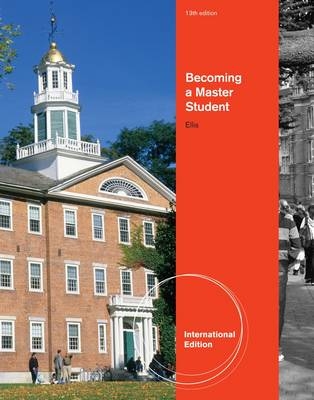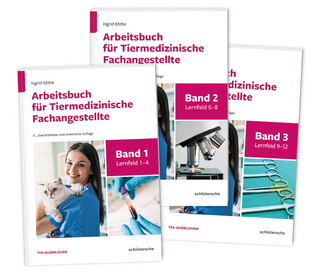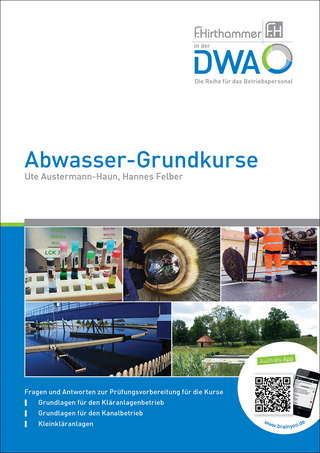
Becoming a Master Student, International Edition
Wadsworth Publishing Co Inc (Verlag)
978-1-4390-8619-3 (ISBN)
- Titel erscheint in neuer Auflage
- Artikel merken
Dave Ellis is a leadership coach, author, educator, and philanthropist. He is a respected lecturer and electrifying workshop leader who has captivated audiences worldwide since first sharing his principles in 1979. Ellis got started in education in 1976, when he taught junior high school math. After getting a master's degree in mathematics, he taught computer science for six years at National American University, where he became Assistant Dean of Student Services. In 1979, he designed a course to improve student retention and then traveled the country for a decade conducting workshops for teachers on ways to improve student retention and test scores. He began training coaches in 1983 and started a public course for coaches in 1993. He puts into practice the principles he teaches, utilizing his remarkable system in his own life. His friends and colleagues often describe him as the happiest person they know with an amazingly wonderful life. He is president of Breakthrough Enterprises, a publishing and consulting company, as well as founder and president of The Brande Foundation, a nonprofit organization offering assistance to organizations working toward world sufficiency, environmental integrity, human rights, and personal transformation. Ellis has contributed millions of dollars to the work of his foundation and other organizations. You can visit Ellis's website at www.fallingawake.com. Ellis resides in the San Francisco Bay Area with his wife Trisha. They have four daughters and six grandchildren.
Note: Each chapter begins with Master Student Map and ends with Put It to Work, Quiz, and Skills Snapshot.
INTRODUCTION: MAKING TRANSITIONS.
This book is worthless—if you just read it. This book is worth $1,000. Exercise #1: Textbook Reconnaissance. Get the most out of this book. Exercise #2: Commitment. The Discovery and Intention Journal Entry System. Rewrite this book. Discovery and Intention Statement Guidelines. Journal Entry #1: Recalling Excellence. Making the transition to higher education. Journal Entry 2: Plan for transition. Classroom civility: what’s in it for you. Succeeding in higher education—at any age. Connect to resources. Extracurricular activities: Read the benefits. Link to the world of work. You don’t need this course—and you might want it. Ways to change a habit. Journal Entry #3: Choosing your purpose. The Power Processes—a user guide. Power Process: Discover what you want.
1. FIRST STEPS.
First Step: Truth is a key to mastery. Journal Entry #4: Create value from this chapter. Exercise 3: Taking the First Step. Exercise #4: The Discovery Wheel. Journal Entry #5: Roll your Discovery Wheel. Mastering Technology: Supplement your text with computer resources. Learning Styles: Discovering how you learn Learning Style Inventory Take a snapshot of your learning styles Scoring your Inventory Learning Style Graph Learning styles across the curriculum Returning to the big picture about learning styles Balancing your preferences. Using your learning style profile to succeed. When learning styles conflict, you have options. Claim your multiple intelligences. Learning by seeing, hearing, and moving: The VAK system. The magic of metacognition. Journal Entry #6: Learning about learning—putting it all together. The Master Student. The value of higher education. Motivation—I’m just not in the mood. Attitudes, affirmations, and visualizations. Attitude replacements. Exercise #5: Reprogram your attitude. Practicing critical thinking 1. Master Student Profiles. Power Process: Ideas are tools. Put it to work. Chapter 1 Quiz. Take a skills snapshot. Master student profile.
2. TIME
You’ve got the time. Journal Entry #7: Create value from this chapter. Exercise #7: The Time Monitor/Time Plan Process. Journal Entry #8: reflect on how you spend the time of your life. Setting and achieving goals. Exercise #8: Seeing where all the time goes. Exercise #9: Get real with your goals. The ABC daily to-do list. Exercise #10: Create a lifeline. Mastering Technology: Use Web-based tools to save time. More strategies for planning. Stop procrastination now. The seven-day anti-procrastination plan. Practicing critical thinking 2. 25 ways to get the most out of now. Keep on going? Remember cultural differences. Beyond time management: Stay focused on what matters. Forget time management—just get things done. Exercise #11: Master monthly calendar. Gearing up: Using a long-term planner. Power Process: Be here now. Put it to work. Chapter 2 Quiz. Take a Skills Snapshot.
3. MEMORY.
Take your memory out of the closet. Journal entry 9: Create value from this chapter. The memory jungle. 20 memory techniques. Exercise 13 Use Q-cards to reinforce memory. Set a trap for your memory. Journal entry: Revisit your memory skills. Exercise 14 Remembering your car keys—or anything else. Keep your brain fit for life. Remembering NAMES. Mnemonic devices. Exercise 15 Get creative. Mastering technology Use your computer to enhance memory. Notable failures. practicing critical thinking 3. Exercise 16 Move from problems to solutions. power process: Love your problems (and experience your barriers). Put it to work. Chapter 3 Quiz. Take a skills snapshot. Master student profile: Pablo Alvarado.
4. READING.
Muscle Reading. Journal entry 11: Discover what you want from this chapter. How Muscle Reading works. PHASE 1 Before you read. PHASE 2 While you read. Five smart ways to highlight a text. PHASE 3 After you read. Muscle Reading—a leaner approach. Journal Entry XX: Experimenting with muscle reading. When reading is tough. Mastering technology Find what you want on the Internet. Reading fast. Exercise 19 Relax. Read with a dictionary or laptop in your lap. The twenty-first century researcher—using your library. Staying Literate in the Digital Age. English as a second language. Reading with children underfoot. Practicing critical thinking 4. Power process: Notice your pictures and let them go. Put it to work. Chapter 4 Quiz. Take a Skills Snapshot. Master student profile: Wilma Mankiller.
5. NOTES.
The note-taking process flows. Journal entry 12: Get what you want from this chapter. OBSERVE: The note-taking process flows. Journal entry 13: Create more value from lectures. What to do when you miss a class. Record: The note-taking process flows. REVIEW: The note-taking process flows. Journal entry 14: Reflect on your review habits. Enroll your instructor in your education. Meeting with your instructor. When your instructor talks fast. Exercise 21 Television note taking. Taking notes while reading. Note this information about your sources. Exercise 22 revisit your goals. Get to the bones of your book with concept maps. Taking notes . . . despite PowerPoint. Online classes—taking notes and using other review tools. Practicing critical thinking 5. Mastering Technology Your mind, online. Power process: I create it all. Put it to work. Chapter 5 Quiz. Take a Skills Snapshot. Master student profile: Harvey Milk.
6. TESTS.
Disarm tests. Journal entry 15: Use this chapter to transform your experience of tests. What to do before the test. How to cram (even though you “shouldn’t”). Ways to predict test questions. Cooperative learning. Mastering Technology: Collaboration 2.0. What to do during the test. F is for feedback, not failure. Words to watch for in essay questions. The test isn’t over until . . . The high costs of cheating. Perils of high-tech cheating. Let go of test anxiety. Have some FUN! Exercise 24 Twenty things I like to do. Journal entry 16: Notice your excuses and let them go. Journal entry 17: Explore your feelings about tests. Getting ready for math tests. Succeeding in science courses. Exercise 25 Use learning styles for math success. Celebrate mistakes. Practicing critical thinking 6. Power process: DETACH. Put it to work. Chapter 6 Quiz. Take a Skills Snapshot. Master student profile.
7. THINKING.
Master Student Map. Critical thinking: A survival skill. Journal entry 18 Discovery/Intention Statement: Choose to create value from this chapter. Becoming a critical thinker. Four more questions for critical thinking. Attitudes of a critical thinker. Finding “aha!” Creativity fuels critical thinking. Tangram. Ways to create ideas. Creative ways for groups to get “unstuck”. Create on your feet. Don’t fool yourself: Fifteen common mistakes in logic. Uncovering assumptions. Gaining skill at decision making. Four ways to solve problems. Choosing your major. Exercise 27 Make a trial choice of major. Asking questions—Learning through inquiry. Practicing critical thinking 7. Think critically about information on the Internet. Mastering Technology: Rethinking email. Exercise 28 Explore emotional reactions. Exercise 29 Translating goals into action. Journal entry 19 Discovery/Intention Statement: Reflect on choosing a major. Power process: Find a bigger problem. Put it to work. Chapter 7 Quiz. Skills Snapshot. Master student profile: Twyla Tharp.
8. COMMUNICATING.
Communicating creates our world. Journal entry 20 Discovery/Intention Statement: Commit to create value from this chapter. Communication—keeping the channels open. Exercise 32 Practice sending or receiving. Choosing to listen. Choosing to speak. Journal entry 21 Discovery/Intention Statement: Discover communication styles. Developing emotional intelligence. Five ways to say “I”. Exercise 33 Write an “I” message. Managing conflict. Journal entry 22 Discovery/Intention Statement. Recreate a relationship. Resolve conflicts with roommates. Five ways to say no . . . gracefully. You deserve compliments. 7 steps to effective complaints. Criticism really can be constructive. Exercise 34 V.I.P.S (Very Important Persons). Collaborating for success. Staying smart in cyberspace—safe social networking. Text message etiquette—Five key points. Mastering Technology: Master students—get networked. Three phases of effective writing. Journal entry 23 Discovery Statement: Take a First Step about writing. Academic integrity: Avoid plagiarism. Mastering public speaking. Making the grade in group presentations. Practicing critical thinking 8. Power process: Employ your word. Put it to work. Chapter 8 Quiz. Skills Snapshot. Master student profile: Sampson Davis.
9. DIVERSITY.
Waking up to diversity. Journal entry 24 Discovery/Intention Statement: Commit to create value from this chapter. Diversity is real—and valuable. Building relationships across cultures. Exercise 35 Becoming a culture learner. Overcome stereotypes with critical thinking. Students with disabilities: Know your rights. Dealing with sexism and sexual harassment. Strategies for nonsexist communication. Leadership in a diverse world. Journal entry 25 Discovery/Intention Statement: Removing barriers to communication. Journal entry 26 Discovery Statement: Reflect on the quality of a recent conversation. Practicing critical thinking 9. Mastering Technology: Making technology accessible. Power process: Choose your conversations and your community. Put it to work. Chapter 9 Quiz. Skills Snapshot. Master student profile.
10. MONEY.
Three paths to financial freedom. Journal Entry 27 Discovery/Intention Statement: Commit to a new experience of money. Exercise 36 The Money Monitor/Money Plan. Journal entry 28 Discovery/Intention Statement: Reflect on your Money Monitor/Money Plan. Make more money. Mastering Technology Protect your money online. Spend less money. Exercise 37 Show me the money. Managing money during tough times. Take charge of your credit. Common credit terms. If you’re in trouble . . . Money for the future. YOU can pay for SCHOOL. Education is worth it. Your learning styles and your money. Exercise 38 Education by the hour. We live like ROYALTY. Free fun. Practicing critical thinking 10. Power process: Risk being a fool. Put it to work. Chapter 10 Quiz. Skills Snapshot. Master student profile: Lisa Price.
11. HEALTH.
Wake up to health. Journal entry 29 Discovery Statement: Take a First Step about your health. Choose your fuel. Prevent and treat eating disorders. Choose to exercise. Choose mental health. Choose to rest. Choose to stay safe. Observe thyself. Choose sexual health: prevent infection. Choose sexual health: Prevent unwanted pregnancy. Journal Entry 30: Discovery/Intention Statement: Choose a new level of health. Men, consider your health. Mastering Technology: Setting limits on screen time. Developing self-esteem. Emotional pain is not a sickness. Suicide is no solution. Alcohol, tobacco, and drugs: THE TRUTH. Exercise 39 Addiction: How do I know . . . ? Some facts . . . From dependence to recovery. Succeed in quitting smoking. Practicing critical thinking 11. Warning: Advertising can be dangerous to your health. Journal entry 31 Discovery/Intention Statement. Crazed glazed donut runs amok. Power process: SURRENDER. Put it to work. Chapter 11 Quiz. Skills Snapshot. Master student profile.
12. WHAT’S NEXT?
Master Student Map. Now that you’re done—begin. Journal entry 32 Discovery/Intention Statement: Revisiting what you want and how you intend to get it. ”. . . use the following suggestions to continue . . . ” Mastering Technology: Continue your education at Internet University. Create your career now. Exercise 40 Create your career plan—now. Exercise 41 Recognize your skills. Sample career plans. Jumpstart your education with transferable skills. 65 transferable skills. Use résumés and interviews to “hire” an employer. Exercise 42 Do something you can’t. Surviving your first day on a new job. Choosing schools . . . again. Contributing: The art of selfishness. Becoming a Master Student goes green. Service learning: The art of learning by contributing. Practicing critical thinking 12. Define your values align your actions. Exercise 43 The Discovery Wheel—Coming full circle. Journal entry 33 Discovery/Intention Statement: Revisiting your Discovery Wheels. Exercise 44 This book shouts, “Use me!” Exercise 45 Create your next semester. Power process: Be it. Put it to work. Chapter 12 Quiz. Master student profile.
| Erscheint lt. Verlag | 3.2.2010 |
|---|---|
| Verlagsort | Belmont, CA |
| Sprache | englisch |
| Maße | 217 x 276 mm |
| Gewicht | 957 g |
| Themenwelt | Sozialwissenschaften ► Pädagogik ► Berufspädagogik |
| Schlagworte | Studium |
| ISBN-10 | 1-4390-8619-2 / 1439086192 |
| ISBN-13 | 978-1-4390-8619-3 / 9781439086193 |
| Zustand | Neuware |
| Informationen gemäß Produktsicherheitsverordnung (GPSR) | |
| Haben Sie eine Frage zum Produkt? |
aus dem Bereich



